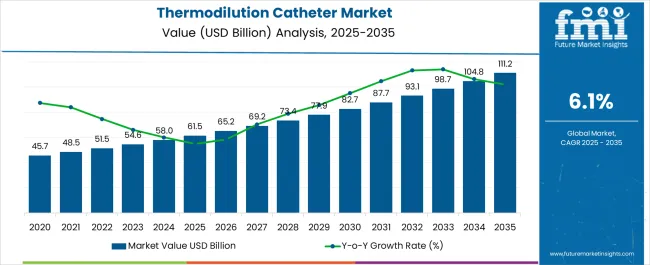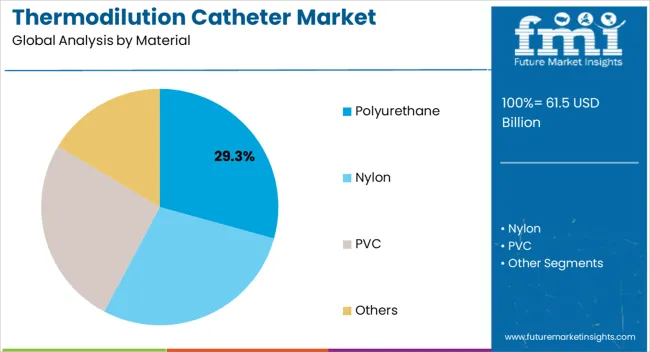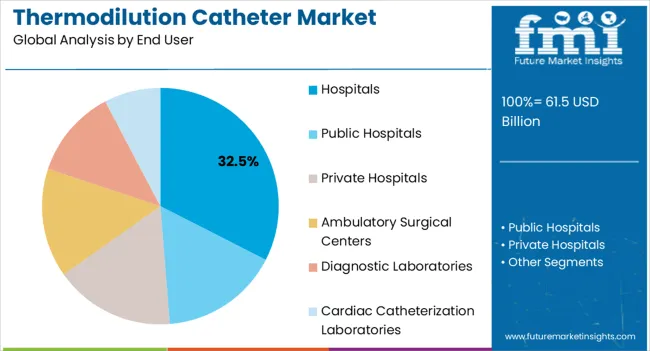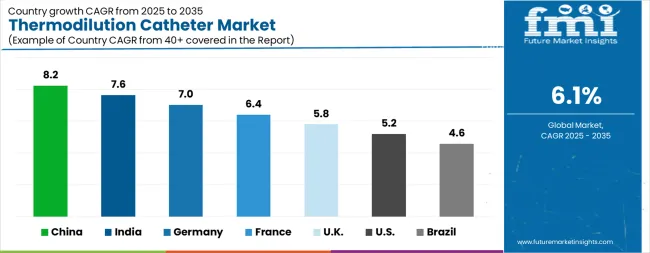The Thermodilution Catheter Market is estimated to be valued at USD 61.5 billion in 2025 and is projected to reach USD 111.2 billion by 2035, registering a compound annual growth rate (CAGR) of 6.1% over the forecast period.

| Metric | Value |
|---|---|
| Thermodilution Catheter Market Estimated Value in (2025 E) | USD 61.5 billion |
| Thermodilution Catheter Market Forecast Value in (2035 F) | USD 111.2 billion |
| Forecast CAGR (2025 to 2035) | 6.1% |
The thermodilution catheter market is witnessing steady growth, supported by its critical role in advanced hemodynamic monitoring and cardiac output measurement. Increasing prevalence of cardiovascular diseases, rising surgical procedures, and growing demand for minimally invasive diagnostic solutions are contributing to sustained adoption. Hospitals and critical care facilities are prioritizing precise hemodynamic assessment tools to improve patient outcomes, particularly in cases of complex cardiac and pulmonary disorders.
Advancements in catheter design and material technologies are improving biocompatibility, durability, and accuracy, enhancing their suitability for long-term clinical use. Regulatory guidelines that emphasize accurate monitoring of cardiac function in high-risk patients are further reinforcing the adoption of thermodilution catheters. Moreover, the rising geriatric population and increasing global healthcare expenditure are creating favorable conditions for market expansion.
With ongoing clinical research supporting improved accuracy and usability, thermodilution catheters are expected to remain a preferred tool for clinicians As healthcare systems continue to invest in critical care infrastructure, the market is positioned for sustainable growth driven by demand for reliable and effective monitoring technologies.
The thermodilution catheter market is segmented by material, end user, and geographic regions. By material, thermodilution catheter market is divided into Polyurethane, Nylon, PVC, and Others. In terms of end user, thermodilution catheter market is classified into Hospitals, Public Hospitals, Private Hospitals, Ambulatory Surgical Centers, Diagnostic Laboratories, and Cardiac Catheterization Laboratories. Regionally, the thermodilution catheter industry is classified into North America, Latin America, Western Europe, Eastern Europe, Balkan & Baltic Countries, Russia & Belarus, Central Asia, East Asia, South Asia & Pacific, and the Middle East & Africa.

The polyurethane material segment is projected to hold 29.3% of the thermodilution catheter market revenue share in 2025, making it the leading material category. Its dominance is being supported by favorable properties such as flexibility, durability, and superior biocompatibility, which allow for safe and effective use in prolonged clinical procedures. Polyurethane catheters are less prone to kinking and mechanical stress compared to alternative materials, ensuring consistent performance during critical monitoring.
The smooth surface of polyurethane reduces the risk of thrombus formation, improving patient safety and lowering complication rates. Hospitals and healthcare providers are favoring polyurethane-based catheters due to their ability to withstand sterilization processes while maintaining structural integrity. Growing demand for materials that enhance patient comfort during invasive procedures is further reinforcing their adoption.
Continuous improvements in polymer science are enabling manufacturers to produce catheters with optimized mechanical and functional properties As the need for reliable cardiac output monitoring increases globally, the polyurethane segment is expected to sustain its leadership, supported by its ability to deliver precision and safety across diverse clinical settings.

The hospitals segment is anticipated to account for 32.5% of the thermodilution catheter market revenue share in 2025, positioning it as the leading end-user category. Its leadership is being driven by the high volume of cardiovascular procedures and the concentration of critical care units within hospital environments. Hospitals are the primary centers for advanced diagnostic and therapeutic interventions, making them the largest consumers of thermodilution catheters.
The increasing prevalence of heart failure, pulmonary hypertension, and other cardiovascular conditions is leading to greater demand for accurate cardiac output monitoring within these facilities. Hospitals are also benefiting from the availability of skilled healthcare professionals and advanced infrastructure, which facilitates the effective use of invasive monitoring technologies. Rising investments in cardiac care units and intensive care departments are further stimulating adoption.
Additionally, hospitals are increasingly focusing on reducing mortality and complications through precise hemodynamic monitoring, driving demand for thermodilution catheters As global healthcare systems expand access to specialized cardiac services, the hospital segment is expected to maintain its leading position and continue fueling overall market growth.
Catheter is medical device made from medical grade material having wide range of application in various medical fields such as neurovascular, cardiovascular, urology, nephrology, gynecology, and gastroenterology. Catheter is a thin tube that can be injected in the body to treat diseases or perform a surgical procedure. The process of inserting a catheter inside the human body is known as catheterization.
A wide range of polymers are used for production of catheters including silicon, rubber, nylon, latex and others. Silicon is most preferred polymer for manufacturing of catheter but this polymer is mechanically weak and can cause serious facture during surgery. Different types of cardiac catheters are used for treatment of different cardiac conditions. Cardiac catheters are of various types include angiographic balloon catheters, bipolar pacing pins, hexapolar balloon pacing catheters, semi flotating electrodes, wedge pressure catheter, thermodilution catheter and others.
Thermodilution Catheter are frequently referred as pulmonary artery catheter (PAC) or Swan-Ganz catheter, in honor of its inventors Jeremy Swan and William Ganz.It is used to determine cardiac output by passing a catheter with a thermistor through the heart. It is also used in conjunction with disposable pressure transducer kits to monitor intravascular and intra-cardiac pressures.
The market of thermodilution catheter is supposed to driven by frequent increase in cardiovascular diseases. Growing aging population and rise in demand for minimally invasive surgeries are expected to drive thermodilution catheters market globally.
Growing population and economies in developing countries such as India and China are expected to drive the growth of the thermodilution catheter market in Asia. Government interest for improvement of healthcare infrastructure can be important factor for rise in thermodilution catheter market. High cost involved in cardiac surgery procedures and lack of experienced and skilled professionals can limit the growth of catheters global market. The increase in prices of thermodilution catheter by key players can also retrains the global market.
Thermodilution catheters market is expected to grow over forecast period due to increasing in the investment in the healthcare sector. Innovation of some new products with focus on patient’s comfort is expected to offer good opportunity for the global cardiac catheters. In addition, new designs of thermodilution catheters which gives rapid and accurate measure of cardiac output have raised their demand in the global market.
Thermodilution catheters market supposed to grow rapidly over the forecast period due to increasing adoption of the technique for cardiovascular therapy by healthcare professionals. Based on type of material used for manufacturing, thermodilution catheter are classified as nylon, polyurethane, PVC and other. Polyurethane thermodilution catheter is supposed to dominate the global market.
Based on end user thermodilution catheter market is classified as Hospitals, Ambulatory Surgical Center, Diagnostic Laboratories and Cardiac Catheterization Laboratory. Thermodilution catheters have been used in hospitals worldwide since 1970. Hospital end user segment is expected to contribute the maximum share among end users.
On the basis of regional presence, global thermodilution catheters market is segmented into five key regions viz. North America, Latin America, Europe, Asia Pacific, and Middle East & Africa. North America is the largest market for thermodilution catheters which is followed by Europe and Asia.
The Asia Pacific is the fastest growing region due to attention of new investors in the catheter market. In Asia Pacific region the developing countries such as India and China are expected to offer good opportunities for the global thermodilution catheter market due to adoption of minimally invasive procedures and advancement in technology.

| Country | CAGR |
|---|---|
| China | 8.2% |
| India | 7.6% |
| Germany | 7.0% |
| France | 6.4% |
| UK | 5.8% |
| USA | 5.2% |
| Brazil | 4.6% |
The Thermodilution Catheter Market is expected to register a CAGR of 6.1% during the forecast period, exhibiting varied country level momentum. China leads with the highest CAGR of 8.2%, followed by India at 7.6%. Developed markets such as Germany, France, and the UK continue to expand steadily, while the USA is likely to grow at consistent rates. Brazil posts the lowest CAGR at 4.6%, yet still underscores a broadly positive trajectory for the global Thermodilution Catheter Market. In 2024, Germany held a dominant revenue in the Western Europe market and is expected to grow with a CAGR of 7.0%. The USA Thermodilution Catheter Market is estimated to be valued at USD 22.6 billion in 2025 and is anticipated to reach a valuation of USD 37.5 billion by 2035. Sales are projected to rise at a CAGR of 5.2% over the forecast period between 2025 and 2035. While Japan and South Korea markets are estimated to be valued at USD 3.1 billion and USD 2.1 billion respectively in 2025.

| Item | Value |
|---|---|
| Quantitative Units | USD 61.5 Billion |
| Material | Polyurethane, Nylon, PVC, and Others |
| End User | Hospitals, Public Hospitals, Private Hospitals, Ambulatory Surgical Centers, Diagnostic Laboratories, and Cardiac Catheterization Laboratories |
| Regions Covered | North America, Europe, Asia-Pacific, Latin America, Middle East & Africa |
| Country Covered | United States, Canada, Germany, France, United Kingdom, China, Japan, India, Brazil, South Africa |
| Key Companies Profiled | Alpha Medical Instruments LLC, Teleflex Incorporated, Edwards Lifesciences, DeRoyal Industries, ICU Medical Inc, Nolato AB, B. Braun Melsungen AG, Merit Medical Systems Inc, Avicenna Healthcare Solutions, and Advanced Lifesciences Pvt Ltd |
The global thermodilution catheter market is estimated to be valued at USD 61.5 billion in 2025.
The market size for the thermodilution catheter market is projected to reach USD 111.2 billion by 2035.
The thermodilution catheter market is expected to grow at a 6.1% CAGR between 2025 and 2035.
The key product types in thermodilution catheter market are polyurethane, nylon, pvc and others.
In terms of end user, hospitals segment to command 32.5% share in the thermodilution catheter market in 2025.






Our Research Products

The "Full Research Suite" delivers actionable market intel, deep dives on markets or technologies, so clients act faster, cut risk, and unlock growth.

The Leaderboard benchmarks and ranks top vendors, classifying them as Established Leaders, Leading Challengers, or Disruptors & Challengers.

Locates where complements amplify value and substitutes erode it, forecasting net impact by horizon

We deliver granular, decision-grade intel: market sizing, 5-year forecasts, pricing, adoption, usage, revenue, and operational KPIs—plus competitor tracking, regulation, and value chains—across 60 countries broadly.

Spot the shifts before they hit your P&L. We track inflection points, adoption curves, pricing moves, and ecosystem plays to show where demand is heading, why it is changing, and what to do next across high-growth markets and disruptive tech

Real-time reads of user behavior. We track shifting priorities, perceptions of today’s and next-gen services, and provider experience, then pace how fast tech moves from trial to adoption, blending buyer, consumer, and channel inputs with social signals (#WhySwitch, #UX).

Partner with our analyst team to build a custom report designed around your business priorities. From analysing market trends to assessing competitors or crafting bespoke datasets, we tailor insights to your needs.
Supplier Intelligence
Discovery & Profiling
Capacity & Footprint
Performance & Risk
Compliance & Governance
Commercial Readiness
Who Supplies Whom
Scorecards & Shortlists
Playbooks & Docs
Category Intelligence
Definition & Scope
Demand & Use Cases
Cost Drivers
Market Structure
Supply Chain Map
Trade & Policy
Operating Norms
Deliverables
Buyer Intelligence
Account Basics
Spend & Scope
Procurement Model
Vendor Requirements
Terms & Policies
Entry Strategy
Pain Points & Triggers
Outputs
Pricing Analysis
Benchmarks
Trends
Should-Cost
Indexation
Landed Cost
Commercial Terms
Deliverables
Brand Analysis
Positioning & Value Prop
Share & Presence
Customer Evidence
Go-to-Market
Digital & Reputation
Compliance & Trust
KPIs & Gaps
Outputs
Full Research Suite comprises of:
Market outlook & trends analysis
Interviews & case studies
Strategic recommendations
Vendor profiles & capabilities analysis
5-year forecasts
8 regions and 60+ country-level data splits
Market segment data splits
12 months of continuous data updates
DELIVERED AS:
PDF EXCEL ONLINE
Catheter Market Insights by Product, Indication, End-user, and Region 2025 to 2035
Catheter-Directed Thrombolysis Market Growth - Trends & Forecast 2025 to 2035
Catheter Tip Syringe Market Size, Share & Demand Outlook 2025 to 2035
Catheter Associated Urinary Tract Infections (UTI) Treatment Market - Demand & Forecast 2025 to 2035
Catheter Systems Market
Transcatheter Mitral Valve Market Size and Share Forecast Outlook 2025 to 2035
Transcatheter Heart Valve Replacement Market Analysis - Trends & Forecast 2025 to 2035
Global Microcatheter Market Analysis – Trends, Size & Forecast 2024-2034
Transcatheter Bioprosthesis Market
Foley Catheter Market Analysis - Size, Share, and Forecast 2025 to 2035
Stroke Catheters Market Analysis - Size, Share, and Forecast Outlook 2025 to 2035
Airway Catheters Market Analysis - Growth & Industry Insights 2025 to 2035
Rectal Catheters Market
Balloon Catheters for Bile Stone Removal Market Size and Share Forecast Outlook 2025 to 2035
Robotic Catheterization Systems Market Growth – Innovations, Trends & Forecast 2025-2035
Balloon Catheters Analysis by Product Type by Indication and by End User through 2035
UK Foley Catheter Market Insights – Size, Trends & Growth 2025-2035
Drainage Catheter Market
Echogenic Catheters Market
Esophageal Catheters Market Size and Share Forecast Outlook 2025 to 2035

Thank you!
You will receive an email from our Business Development Manager. Please be sure to check your SPAM/JUNK folder too.
Chat With
MaRIA